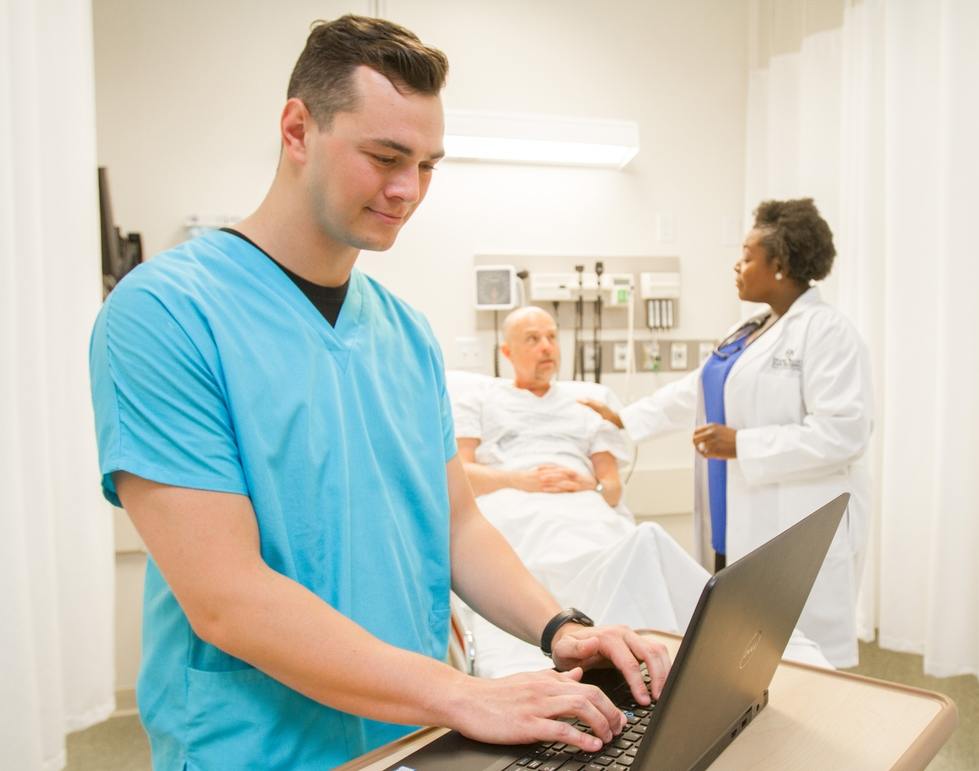Virtual Medical Scribes: Understanding Telescribes and Remote Scribes Virtual Medical Scribes: Understanding Telescribes and Remote Scribes A Virtual Medical Scribe is a professional who documents the patient's encounter with the physician, irrespective of the location and time. Remote Scribing comprises of a real-time working as a writer while connected to a doctor’s office who is attending a patient or performing a simple procedure on a patient in the office. The remote scribe can view and listen to the proceedings and must meticulously enter all the relevant data into the EHR. The scribe must be well versed in medical terminology and drug names and be computer savvy to quickly enter details while the doctor is attending to the patient. Remote scribing is a growing field essential to the healthcare industry's future. Whether someone wants a new career or a place to gain experience, remote scribing presents an exciting opportunity to learn and contribute to healthcare in various ways. Scribes ease the burden on healthcare teams, help medicine progress into the electronic age, and improve patient care. With the approval of the Texas Christian University's administration, the Virtual medical scribe was invented by John Geesbreght, which led to the recruitment of pre-med TCU students for the establishment medicine. Upon invention, the Virtual or tech-enabled-remote scribes proved to offer more ROI and benefit to doctors in 2019. The innovations of the remote scribing purported to elevate the natural conversation between a doctor and a patient and decode it into structural noted in the HER as an output. Through the year of 2019, there was a high demand for a high ratio of human in the loop are required earnestly. Tele-scribing is also about the execution of simple peripheral tasks. These domains generally appeal to medical technician investors and resemble the Alexa-like workflows that consumers experience at home. In practice, these workflows did not save much time and offered doctors a lot of ROI in 2019. Further, there are a lot of workflows that are best done in expert user interfaces. For example, imagine ordering a flight ticket through a phone tree voice interface. The role of a virtual scribe determines a smooth route for physicians to assess and evaluate patients comprehensively. This is accomplished by the detailed description of clinical synopsis documented by a respective virtual scribe assigned to a certain physician. These processes are performed under high-security parameters in a HIPAA-compliant data management center and are connected to examination rooms through secure internet and VoIP connections. Only a few companies are into this at the moment across the world. The services require a lot of compliance, most importantly HIPAA, since it deals with sensitive information and exposure to the clinic setting. Telescribes is almost like a doctor's assistant but works virtually for the doctor and is connected via webcam. The work usually happens when the doctor is in session, corresponding to business hours. Given their familiarity with medical reports, Telescribes can be a good alternative for medical transcriptionist although strenuous if the partake does not have a passion in the field. While Telescribes video promotes patient-doctor privacy, it also allows a live scribe to listen to and decode the conversation from a different room through a secure and easy-to-use app on a mobile tablet. The viewer will hear the dialogue between the doctor and patient as the video shows the remote scribe documenting the visit. Tracking information from doctor visits. Scribe works as an assistant to doctors and collects lab results on patient scribes are focused on patient interaction. In this example of a clinical scenario, one will see the documentation for subjective and objective patient data, including the HPI, ROS, Physical exam (PEx), Assessment, and Plan. Through this system, a remote scribe can easily fulfill different duties such as appointment scheduling, billing, phone call reception, and another sort of inquiries. They note down all the key points, which reduces the physician's additional time spent on notes and documentation. In the clinical setting, a virtual medical scribe may have more responsibilities since the pace is slower and patients are more likely to be stable. Some of these responsibilities include reporting the quality codes mentioned earlier and putting in orders and charges, all under the physician's close supervision, of course. This provides great exposure to medical decision-making for scribes seeking experience in advanced healthcare careers. Through tele-scribing and webcam, the scribe can know and see what tests physicians order for which symptoms and the variety of treatments they provide for different ailments and conditions. However, scribes are heavily used in the emergency department in a hospital setting, although some hospitals utilize them in other areas. Medical scribes can be considered paraprofessionals, making the job easy for doctors by watching and documenting doctor-patient encounters. Currently, there are Virtual Scribes present online and work for physicians. Scribes improve documentation. While being a Virtual Medical Scribe does not require one to attain a college degree, they should be well trained in speed typing, English language, grammar, medical coding, medical conversations, listening, analytical and reasonable skills, and software navigation skill. Working remotely, a medical scribe is a clinical experience through the tele-scribing system. A medical scribe performs a wide range of transcription-related tasks. A personal assistant to the physician performs electric record-keeping responsibilities for the physicians during patient encounters, ensuring the best patient care cannot be accomplished in time. Subsequently, computer competence is also an essential skill for virtual Medical Scribe jobs. It is important not only to be able to type at an above-average speed but to do so while multitasking. The profession needs one to be able to type, listen, and take notes as the physician bounces between dialogue with the patient while giving notes and findings in various parts of the chart. Conclusively, remote scribing is the process where the words and actions of a doctor, surgeon, nurse practitioner, or other medical professional are charted and documented. Medical scribing is an organized and well-esteemed fragment of the US healthcare system; personal assistant helps the physician deliver a high-quality healthcare system. Scribing in a clinic involves a more predictable setting, although sometimes it can be just as intense as in the ER. The benefits and drawbacks of scribing in each setting depend greatly on what one is seeking. Since a Virtual medical scribe works on the documentation of patients' records, the hospital offers scribes more action in which they can promote the work of the doctor. This provides a lot of flexibility in scheduling. They must be quick and not miss out on critical data, as everything happens in real time. The ability to comprehend and good writing abilities all come in handy. Virtual Nurse RX has a team of registered nurses who can help one run a more efficient practice. The virtual scribes are a vital asset to the team by watching and listening to the patient's needs. A medical scribe is a person who assists doctors in charting prescriptions and adding data to EHR.
0 Comments
Your comment will be posted after it is approved.
Leave a Reply. |

ABOUT THE AUTHOR:
Ms. Pinky Maniri-Pescasio is the Founder of GoHealthcare Consulting. She is a National Speaker on Practice Reimbursement and a Physician Advocate. She has served the Medical Practice Industry for more than 25 years as a Professional Medical Practice Consultant. search hereArchives
July 2024
Categories
All
BROWSE HERE
All
|
- About
- Leadership
- Contact Us
- Testimonials
- READ OUR BLOG
-
Let's Meet in Person
- 2023 ORTHOPEDIC VALUE BASED CARE CONFERENCE
- 2023 AAOS Annual Meeting of the American Academy of Orthopaedic Surgeons
- 2023 ASIPP 25th Annual Meeting of the American Society of Interventional Pain Management
- 2023 Becker's 20th Annual Spine, Orthopedic & Pain Management-Driven ASC Conference
- 2023 FSIPP Annual Conference by FSIPP FSPMR Florida Society Of Interventional Pain Physicians
- 2023 New York and New Jersey Pain Medicine Symposium
- Frequently Asked Questions and Answers - GoHealthcare Practice Solutions
- Readers Questions
Photos from shixart1985 (CC BY 2.0), www.ilmicrofono.it, shixart1985







 RSS Feed
RSS Feed